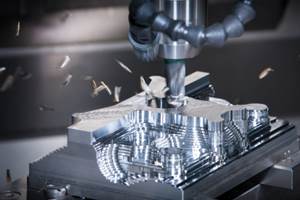Automating Surface Metrology for the Shop Floor
Machine operators are likely to get improved results when the surface finish gage is smart enough to choose the best measuring parameters.
We have come a long way from the not-so-distant past in which surface finish was “measured” by judgment or compared to a standard with a fingernail. Since the inception of roughness metrology, the number of international standards and internationally recognized surface parameters has continually increased. This fact makes it particularly difficult for new employees in the quality room or in production to grasp an overview, let alone the intricacies of surface metrology.
The basics of measuring a surface have been pretty consistent over the past 60 years or so. The surface measuring instrument moves a precision stylus across a surface and the resulting signal, or trace, is analyzed and presented to the user. What’s different today is that there are a host of new parameters and variations to the instrument that can lead to very different results when different settings of the gage parameters are used.
Take filtering and cutoff lengths, for example. There are three components in the surface texture trace, which are filtered to determine specific surface roughness or waviness characteristics. Depending on what filter settings are used, one can remove the waviness element to evaluate the roughness profile or eliminate the roughness elements to evaluate the waviness profile.
Separating the roughness and waviness elements is done using filter cutoffs. Incorrect choice of cutoff length is one of the main reasons for incorrect surface finish results. The cutoff length must be long enough to provide sufficient data for the measurement, but not so long that part geometry can impose extraneous data. A properly specified cutoff usually includes 10 to 15 tool marks for most machined surfaces.
But cutoff length is not to be confused with stroke or traverse length, which is the total distance the probe travels, and may be 2-, 12- or even 18-inches long (50, 300 and 450 mm) in order to evaluate waviness and straightness. Detailed information about the choice of cutoffs is found in Chapters 3 and 4 of ASME B46.1.
A typical surface finish callout consists of many elements, all of which may be required because of the complexity of surface finish metrology. Under the old ANSI B46.1-1985 standard, a default value of 0.030 inch (0.8 mm) was applied to any surface finish callout that did not specify a cutoff. This is an effective cutoff value for many, but not all, roughness measurements. To avoid confusion and lax specifying, the new ASME B46.1-1995 standard abolishes the default and insists that all cutoffs be specified. It is standard procedure to measure five cutoffs within a single stroke and average the results, although fewer may be used if the surface is too short to include five. Where a manufacturing process is known to be consistent, fewer than five cutoffs may be sufficient to generate reliable results. When reporting results, the number of cutoffs should be indicated if it is not five.
So now our machinist—who is used to part programming and helping to assure the quality of the parts coming off the machine—is somehow supposed to become a semi-expert on surface finish standards and parameters as well. For that machinist, this may be too much to ask.
One solution available now is a feature built into some surface gages for automatic cutoff selection. In effect, the measuring system selects the right filters and correct measuring traverse length. This is done automatically while the part is being measured, depending on the magnitude of the value for the width of profile elements (Rsm) or surface roughness depth (Rz) (as per DIN EN ISO 4288 and ASME B46.1).
Once the measurement is complete, the profile can also be filtered automatically with the most appropriate cutoff length depending on the traverse length. Measurement errors and incorrect filter settings are thus avoided.
Of course, this automatic selection should not be used when the blueprints call for specific cutoff lengths or other trace settings. But for general-purpose surface-finish checks, the use of automatic selections can improve results, and is apt to improve correlation between similarly used systems.
Related Content
Understanding G27, G28, G29 and G30
Take a closer look at these reference position commands.
Read MoreUnderstanding The Four Major Behavioral Styles
Companies today are expanding the role of teams in the workplace in an effort to empower employees and improve organizational effectiveness. The more we try to work as a team, the more important it becomes to recognize that people exhibit different behavioral styles.
Read MoreHow to Reduce Cycle Times by 70% and More on Your Existing CNCs and Dramatically Improve Tool Life Too
By employing advanced high efficiency milling techniques for the entire machining routine, SolidCAM’s iMachining technology can drastically reduce cycle times while vastly improving tool life compared to traditional milling.
Read MoreHow To Calibrate Your Calipers
If you’re interested in calibrating your own digital, dial or Vernier calipers, here are some steps to take to make sure it goes off without a hitch.
Read MoreRead Next
Obscure CNC Features That Can Help (or Hurt) You
You cannot begin to take advantage of an available feature if you do not know it exists. Conversely, you will not know how to avoid CNC features that may be detrimental to your process.
Read MoreThe Cut Scene: The Finer Details of Large-Format Machining
Small details and features can have an outsized impact on large parts, such as Barbco’s collapsible utility drill head.
Read More3 Mistakes That Cause CNC Programs to Fail
Despite enhancements to manufacturing technology, there are still issues today that can cause programs to fail. These failures can cause lost time, scrapped parts, damaged machines and even injured operators.
Read More












.png;maxWidth=300;quality=90)













